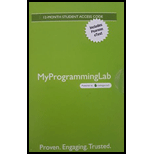
Concept explainers
(a)
Create a Structure inventory which contains the following:
- A character array partName[30]
- An integer partNumber,
- A floating point price
- An integer stock
- An integer reorder.
(a)
Explanation of Solution
Explanation:
A structure is a user defined data type which contains related variables which have same name.
Following syntax is used to create a structure with a keyword struct:
struct <structure name>
{
variable 1;
variable 2;
---;
};
Structure named Inventory with the given variables is defined as follows:
struct Inventory
{
char partName[30];
int partNumber;
float pointprice;
int stock;
int reorder;
};
(b)
Define the union data containing char c, short s, long b, float f and double d.
(b)
Explanation of Solution
Explanation:
Union is a user defined data type which contains related variables just like structure which uses same data space for its variable.
Following syntax is used to create an Union data type:
union <union name>
{
variable 1;
variable 2;
---;
};
Union named data which contains char c, short s, long b, float f and double d is defined as follows:
union data
{
char c;
short s;
long b;
float f;
double d;
};
(c)
Create a structure called address that contains character arrays
- streetAddress[ 25]
- city[ 20 ]
- state[ 3]
- zipCode[ 6].
(c)
Explanation of Solution
Explanation:
A structure is a derived defined data type which contains related variables which have same name.
Following syntax is used to create a structure with a keyword struct:
struct <structure name>
{
variable 1;
variable 2;
---;
};
Structure with the name address containing character arrays is defined as follows:
struct address
{
char streetAddress[25];
char city[20];
char state[3];
char zipCode[6];
};
(d)
Create a structure student that contains the following :
- An character array firstName[15]
- An character array lastName[15]
- variable homeAddress of type struct address.
(d)
Explanation of Solution
Given Information
Structure named address as follows:
struct address
{
char streetAddress[25];
char city[20];
char state[3];
char zipCode[6];
};
Explanation:
A structure is a derived defined data type which contains related variables which have same name but each variable in the structure has its own data space.
Keyword struct is used to create a structure as follows:
struct <structure name>
{
variable 1;
variable 2;
---;
};
Structures can be used to declare variable which can access variables of the structure with the use of following syntax:
struct <structure_name><variable_name>;
Structure name Student which contains a structure
A structure student that contains the variable homeAddress of type struct address along with character arrays firstName and lastName is defined as follows:
struct student
{
char firstName[15];
char lastName[15];
struct address homeAddress;
};
(e)
Create a structure test which contains a 16 bit fields with widths of 1 bit. The names of the bit fields are the letters a to p.
(e)
Explanation of Solution
Explanation:
Bit fields can be defined in the structure which enables user to specify the number of bits a unsigned or int member of variable can store.
Bit fields are defined with the following syntax:
<data type> <bit-field name> <number of bits>
A structure test which contains a 16 bit fields with widths of 1 bit is defined as follows:
struct test
{
unsigned int a : 1;
unsigned int b : 1;
unsigned int c : 1;
unsigned int d : 1;
unsigned int e : 1;
unsigned int f : 1;
unsigned int g : 1;
unsigned int h : 1;
unsigned int i : 1;
unsigned int j : 1;
unsigned int k : 1;
unsigned int l : 1;
unsigned int m : 1;
unsigned int n : 1;
unsigned int o : 1;
unsigned int p : 1;
};
Want to see more full solutions like this?
Chapter 10 Solutions
MYPROGRAMMINGLAB WITH PEARSON ETEXT
 C++ for Engineers and ScientistsComputer ScienceISBN:9781133187844Author:Bronson, Gary J.Publisher:Course Technology Ptr
C++ for Engineers and ScientistsComputer ScienceISBN:9781133187844Author:Bronson, Gary J.Publisher:Course Technology Ptr C++ Programming: From Problem Analysis to Program...Computer ScienceISBN:9781337102087Author:D. S. MalikPublisher:Cengage Learning
C++ Programming: From Problem Analysis to Program...Computer ScienceISBN:9781337102087Author:D. S. MalikPublisher:Cengage Learning EBK JAVA PROGRAMMINGComputer ScienceISBN:9781337671385Author:FARRELLPublisher:CENGAGE LEARNING - CONSIGNMENT
EBK JAVA PROGRAMMINGComputer ScienceISBN:9781337671385Author:FARRELLPublisher:CENGAGE LEARNING - CONSIGNMENT- Programming Logic & Design ComprehensiveComputer ScienceISBN:9781337669405Author:FARRELLPublisher:Cengage
 Programming with Microsoft Visual Basic 2017Computer ScienceISBN:9781337102124Author:Diane ZakPublisher:Cengage Learning
Programming with Microsoft Visual Basic 2017Computer ScienceISBN:9781337102124Author:Diane ZakPublisher:Cengage Learning Systems ArchitectureComputer ScienceISBN:9781305080195Author:Stephen D. BurdPublisher:Cengage Learning
Systems ArchitectureComputer ScienceISBN:9781305080195Author:Stephen D. BurdPublisher:Cengage Learning





